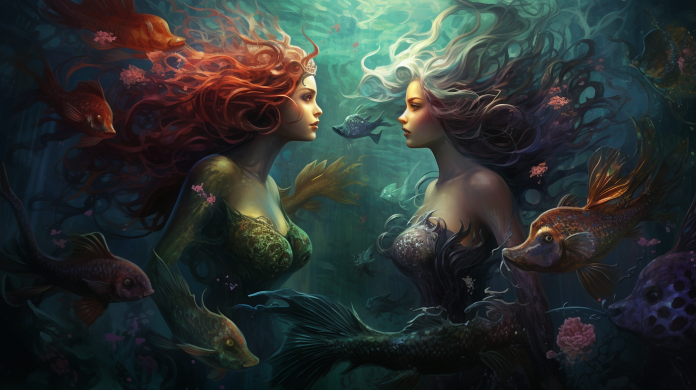Long before Disney’s Ariel sang under the sea, stories of mermaids—half-human, half-fish beings—echoed through seafaring civilizations. But depending on where you look, these mythical creatures are benevolent ocean spirits, omens of doom, or deadly seductresses pulling sailors to watery graves.
So, what’s the truth behind the scales? Are mermaids celestial guides—or cunning sea witches? Let’s swim through myth, magic, and maritime terror to explore how mermaids across cultures reveal the depths of human imagination.
Mermaids in Ancient Civilizations
Assyria: Atargatis, the First Mermaid?
One of the earliest mermaid legends traces back to 1000 BCE, with the Assyrian goddess Atargatis, who transformed into a mermaid out of shame after accidentally killing her human lover. Though often depicted as a goddess of fertility and water, this myth laid the foundation for later mermaid symbolism—beauty, tragedy, and transformation.
Greece: Sirens Evolve from Bird to Fish
Greek sirens weren’t always mermaids—they began as bird-women. Over time, especially during the Middle Ages, their imagery blended with mermaids, turning them into the seductive, singing sea maidens who lured sailors to shipwreck with haunting voices.
Homer’s Odyssey and later European folklore solidified the idea of mermaids as dangerous seductresses, blending beauty with fatal charm.
Mermaids in European Folklore: Warnings from the Deep
Across Europe, mermaid tales often come with a warning label:
Scotland & Ireland – Selkies: Shapeshifting seal-people who shed their skins to walk on land. If their skin is stolen, they’re trapped in human form—often used to explore themes of freedom and captivity.
Germany – Lorelei: A river maiden who sat on cliffs above the Rhine, singing sailors to their deaths. Her legend highlights the fatal attraction of beauty.
Russia – Rusalka: Restless female spirits of drowned women. In some tales, they’re tragic and mournful; in others, they drown men in revenge.
While some mermaids were seen as romantic or even helpful, others were clearly used to explain shipwrecks, storms, or seduction gone wrong.
African and Caribbean Lore: Water Spirits with Power
In many African and Afro-Caribbean traditions, mermaid-like figures are powerful spiritual beings, not monsters.
Mami Wata (West Africa)
A divine, seductive spirit who can bless or curse, Mami Wata is often shown with long flowing hair, jewelry, and a serpent. She represents wealth, healing, and sexuality, and followers still leave offerings at rivers and seas.
La Sirène (Haitian Vodou)
Part of the Vodou pantheon, La Sirène rules the seas and music. She can bring prosperity or madness, depending on how she’s treated. These myths showcase mermaids as agents of fate and spiritual power, not just beauty.
Asia’s Oceanic Spirits: Guardians and Ghosts
Japan – Ningyo
Far from the Western image, Japan’s Ningyo is a fish-like creature with a monkey’s mouth. Eating its flesh brings immortality, but catching one can cause storms. A rare and strange mix of blessing and bad luck.
Indonesia – Nyai Roro Kidul
Queen of the Southern Sea, she’s a powerful goddess-queen said to drown those who disrespect her or wear green near the ocean. She’s worshipped as a force of natural balance, punishment, and royalty.
Modern Mermaids: Between Fantasy and Feminism
In today’s pop culture, mermaids have shifted again:
Disney’s Ariel popularized the idea of a curious, kind mermaid who wants to explore the human world.
The Lure (2015 Polish film) returned to dark roots—showing mermaids as seductive, cannibalistic predators.
Mermaids in activism (like #MermaidsForClimate) have become symbols of nature, transformation, and feminine power.
Mermaids have become symbols of fluid identity, freedom, rebellion, and self-discovery—especially in LGBTQ+ and feminist spaces.
Final Thoughts: Mythical Maidens or Maritime Monsters?
So, are mermaids beautiful sirens or deadly sea witches? The answer depends on who’s telling the tale.
From protective spirits to treacherous sirens, from divine goddesses to seductive dangers, mermaids across cultures reflect both our awe of the ocean and our complex relationship with desire, danger, and the unknown.
One thing is clear: mermaids have always been more than fairy tales—they are mirrors of culture, emotion, and the deepest depths of human imagination.



